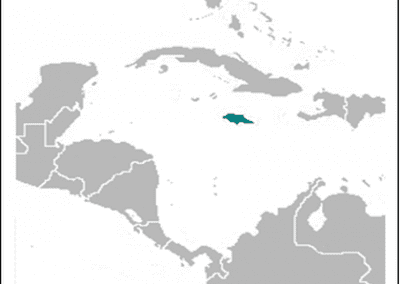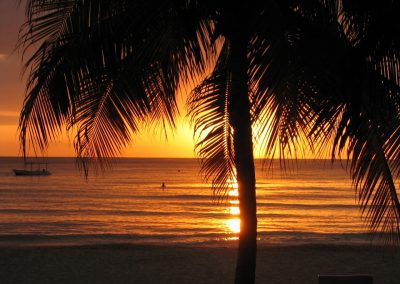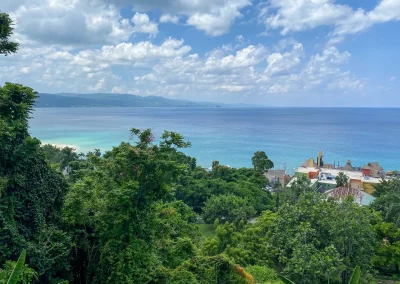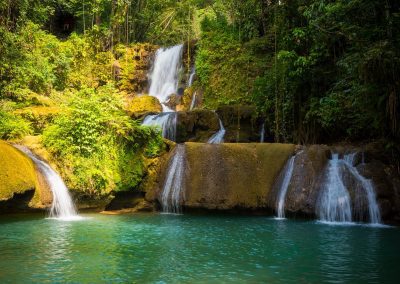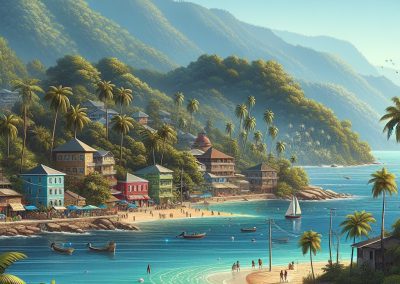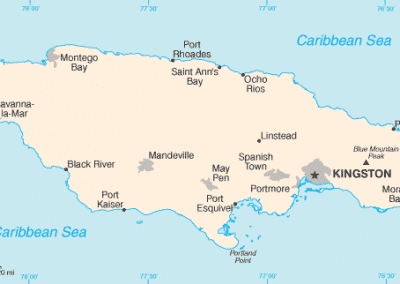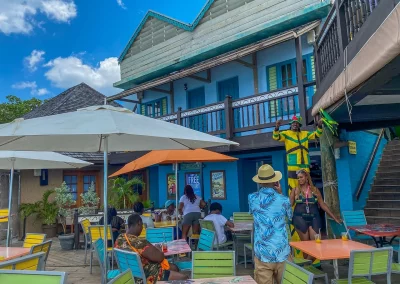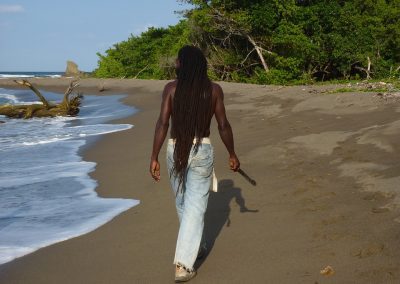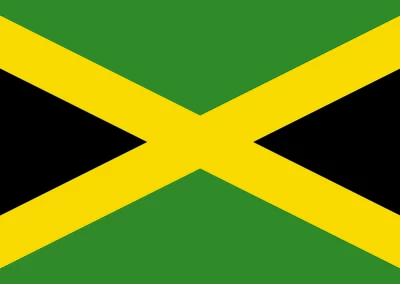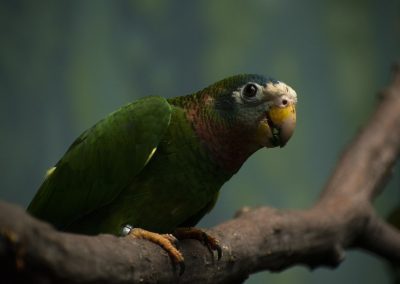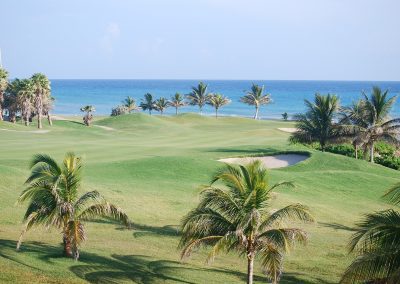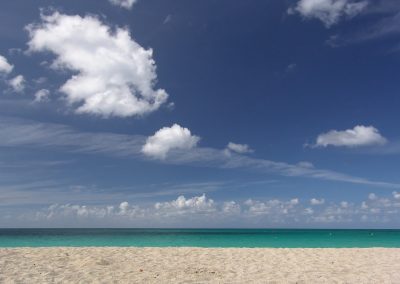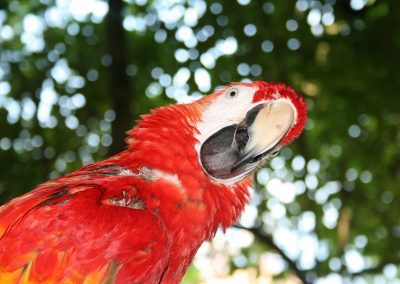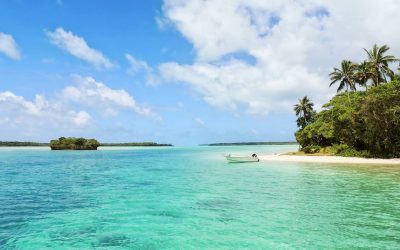Jamaica
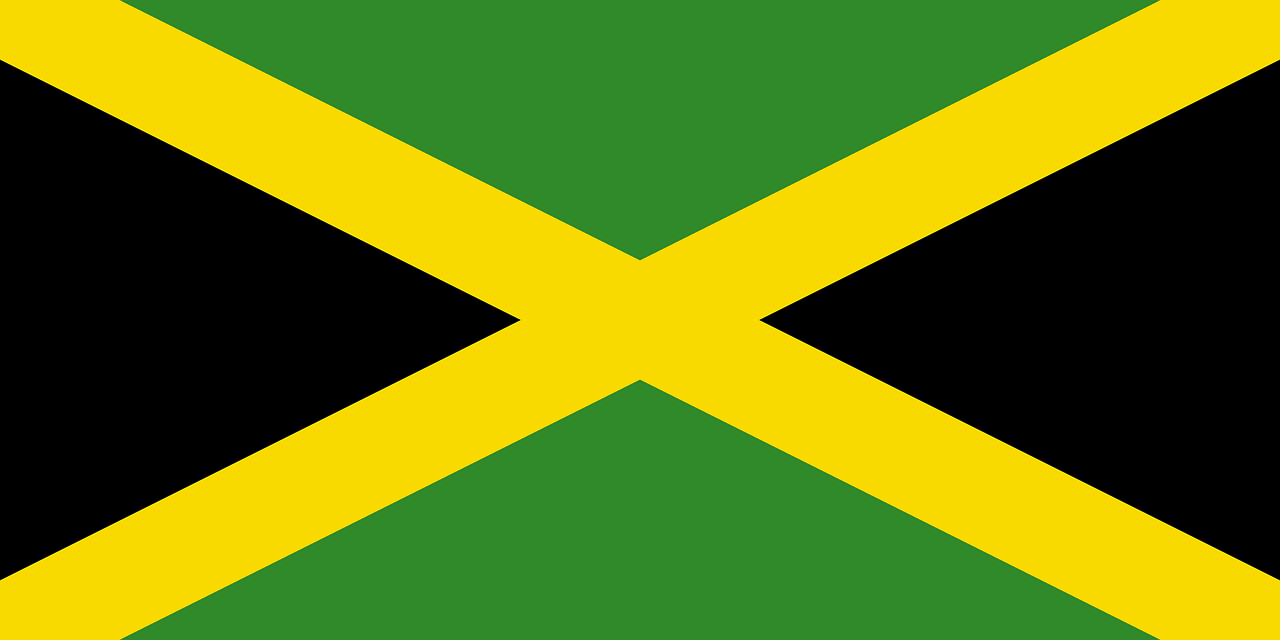
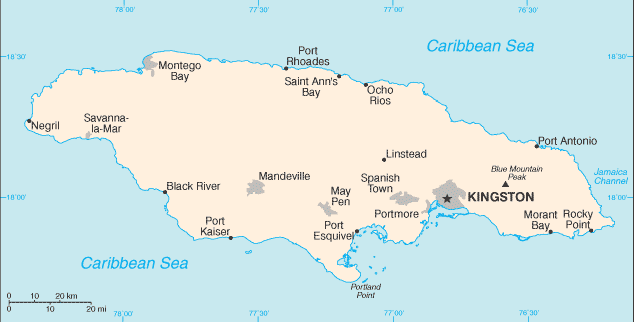

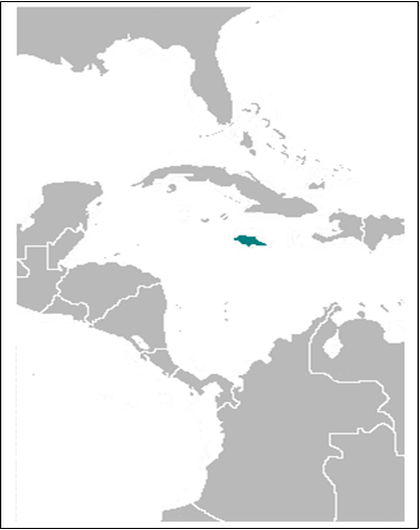

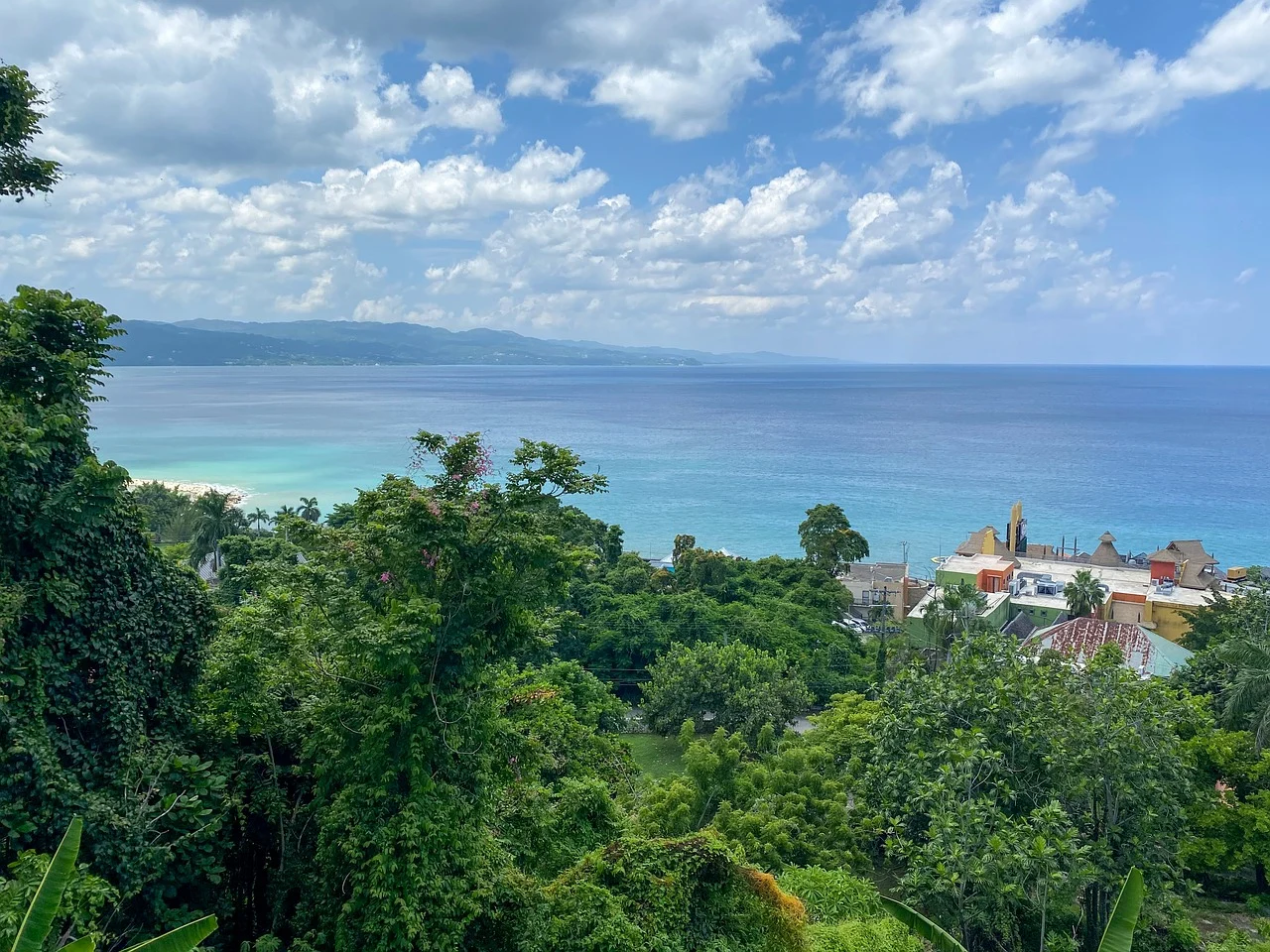
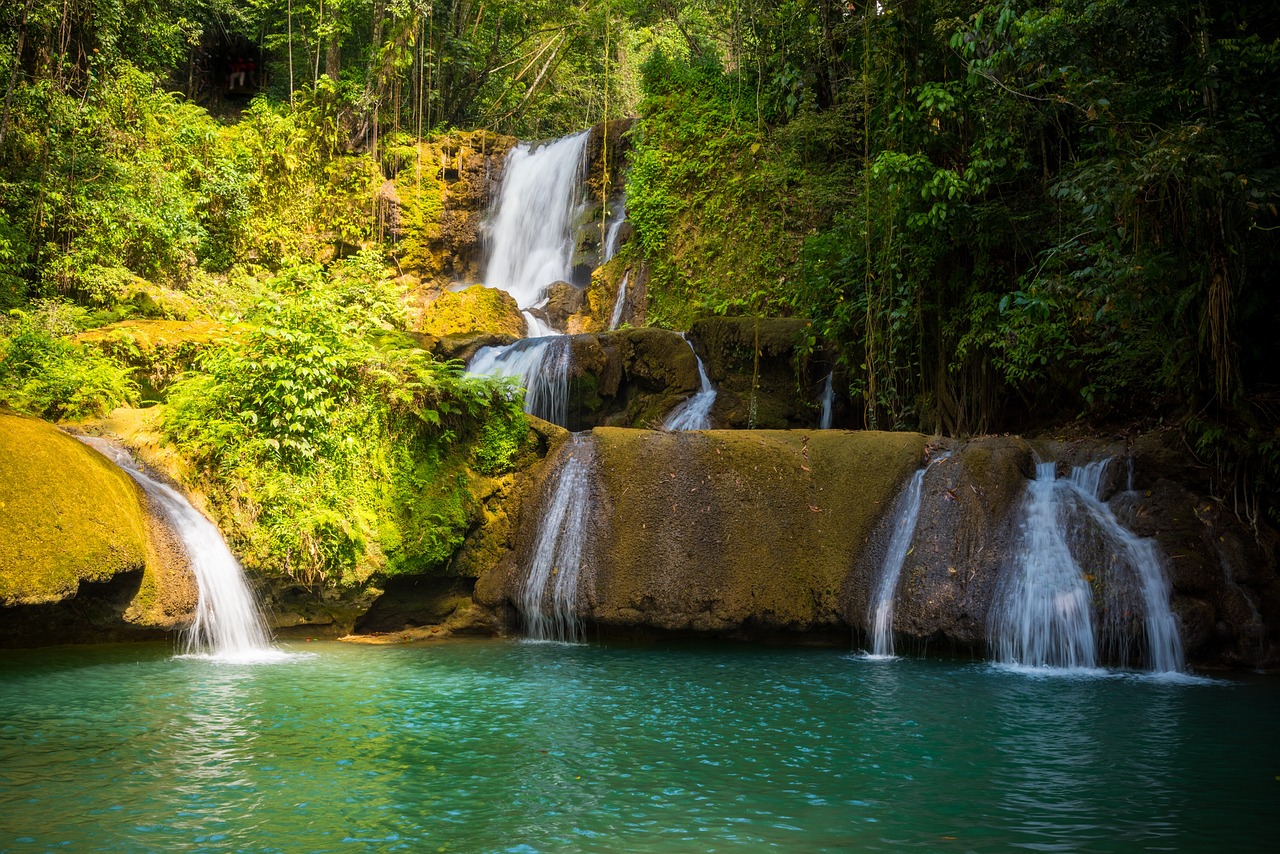
Capital: Kingston
Population (Estimated July 2012): 2,889,187
Area: 10,991 km2 or 4,244 mi2
Currency: Jamaican Dollar (J$)
Official Language: English
Political Information: Parliamentary Democracy and Constitutional Monarchy
Official Religion: No Official Religion (approximately 62.5% of the population are Protestants, 2.6% are Roman Catholics, 14.2% have other or unspecified religious beliefs and 20.9% have no religious beliefs)
Highest Mountain: Blue Mountain Peak at 2,256 m or 7,402ft
GDP Official Exchange Rate (OER is more precise at gauging a countries economic power)
(Estimated 2011): $14.7 billion (US$) or (GBP)
GDP (OER) Per Capita (per member of the population estimated 2011): (US$) or (GBP)
GDP Purchasing Power Parity (PPP is good for gauging living conditions and use of resources but not as accurate as OER. This data has been calculated based on the sum value of all goods and services produced in the country valued at prices prevailing in the United States)
(Estimated 2011): $24.58 billion (US$) or (GBP)
GDP (PPP) Per Capita (per member of the population estimated 2011): $9,000 (US$) or (GBP)
Time Zone (GMT/UTC): -5:00
Wildlife:
Counties/Provinces/States: 14 parishes; Clarendon, Hanover, Kingston, Manchester, Portland, Saint Andrew, Saint Ann, Saint Catherine, Saint Elizabeth, Saint James, Saint Mary, Saint Thomas, Trelawny, Westmoreland
note: for local government purposes, Kingston and Saint Andrew were amalgamated in 1923 into the present single corporate body known as the Kingston and Saint Andrew Corporation
Leaders: H.M. Queen Elizabeth II with Governor-General Sir Patrick Allen and Prime Minister Portia Simpson-Miller
Additional: Gained Independence from the UK on the 6th of August 1962.
Sources: CIA World Fact Book, Encyclopaedia Britannica.
Jamaica
Jamaica is an island nation located in the Caribbean Sea, known for its stunning beaches, vibrant culture, and reggae music. The country is the third-largest island in the Caribbean and is home to a population of approximately 2.9 million people. The capital city of Jamaica is Kingston, which is also the largest city in the country. Jamaica gained independence from the United Kingdom in 1962 and has since become a popular tourist destination, attracting visitors from all over the world. The official language of Jamaica is English, and the currency is the Jamaican dollar. The country is famous for its warm and welcoming people, as well as its rich history and diverse cultural heritage.
Jamaica is renowned for its natural beauty, with lush rainforests, majestic mountains, and crystal-clear waters. The island’s tropical climate and stunning landscapes make it a paradise for outdoor enthusiasts and nature lovers. Whether you’re looking to relax on the beach, explore the vibrant cities, or immerse yourself in the local culture, Jamaica has something to offer for everyone. From the iconic Blue Mountains to the famous Dunn’s River Falls, there are countless attractions to discover on this enchanting island. With its laid-back atmosphere and infectious rhythm, Jamaica is a destination that will capture your heart and leave you longing to return again and again.
History and Culture of Jamaica
The history of Jamaica is a complex tapestry woven with influences from indigenous Taino people, European colonizers, African slaves, and East Indian indentured labourers. The island was originally inhabited by the Taino people before being colonized by the Spanish in the 15th century. In 1655, Jamaica was captured by the British and became a major hub for the transatlantic slave trade. The legacy of slavery has had a profound impact on Jamaican culture, shaping its music, language, and traditions. The island’s rich cultural heritage is celebrated through its vibrant festivals, such as the annual Reggae Sumfest and the lively street parties known as “dancehall sessions.”
Jamaica is also famous for its influential music scene, particularly reggae, which was popularized by legendary musician Bob Marley. Reggae music has become synonymous with Jamaican culture and has had a significant impact on music worldwide. The island’s cuisine is a delicious fusion of African, European, and Indian flavours, with dishes such as jerk chicken, ackee and saltfish, and curry goat being popular staples. Jamaican culture is also reflected in its vibrant art scene, with colourful murals adorning the streets and galleries showcasing the work of local artists. The warmth and friendliness of the Jamaican people are evident in their hospitality and strong sense of community, making it a truly special place to visit.
Geography and Climate of Jamaica
Jamaica is a stunning island located in the Caribbean Sea, with a diverse landscape that includes mountains, rainforests, and beautiful beaches. The island is approximately 146 miles long and 51 miles wide, with a total area of 4,240 square miles. The Blue Mountains, located in the eastern part of the island, are the highest mountain range in Jamaica and are known for their breathtaking views and lush vegetation. The island’s coastline is dotted with picturesque coves and bays, with some of the most famous beaches including Negril, Montego Bay, and Ocho Rios.
The climate in Jamaica is tropical, with warm temperatures throughout the year. The island experiences a wet season from May to October and a dry season from November to April. The average temperature in Jamaica ranges from 77°F to 86°F, making it an ideal destination for sun-seekers. The warm waters of the Caribbean Sea provide excellent conditions for swimming, snorkelling, and diving, with an abundance of marine life and coral reefs to explore. Jamaica’s natural beauty and pleasant climate make it a paradise for outdoor activities such as hiking, birdwatching, and water sports.
Famous Attractions in Jamaica
Jamaica is home to a wealth of famous attractions that showcase the island’s natural beauty and rich cultural heritage. One of the most iconic landmarks in Jamaica is Dunn’s River Falls, a stunning waterfall that cascades over limestone terraces into the Caribbean Sea. Visitors can climb the falls with the help of experienced guides or simply relax on the beach and admire the breathtaking scenery. Another must-see destination is the Blue Mountains National Park, which offers spectacular hiking trails, coffee plantations, and panoramic views of the island.
For those interested in history and culture, a visit to the Bob Marley Museum in Kingston is a must. The museum is located in Marley’s former home and showcases memorabilia, photographs, and personal items belonging to the reggae legend. In Ocho Rios, visitors can explore the enchanting Green Grotto Caves, which are filled with stalactites, stalagmites, and underground lakes. The vibrant city of Montego Bay is known for its lively atmosphere and beautiful beaches, while Negril is famous for its stunning sunsets and Seven Mile Beach. Whether you’re seeking adventure, relaxation, or cultural experiences, Jamaica has something to offer for every type of traveller.
Jamaican Cuisine and Music
Jamaican cuisine is a delicious fusion of flavours influenced by African, European, and Indian culinary traditions. One of the most famous dishes in Jamaican cuisine is jerk chicken, which is marinated in a spicy blend of herbs and spices before being grilled to perfection. Another popular dish is ackee and saltfish, a savoury combination of salted codfish and ackee fruit that is often served with fried dumplings or plantains. Curry goat is another staple of Jamaican cuisine, featuring tender goat meat cooked in a fragrant curry sauce with potatoes and vegetables.
In addition to its mouth-watering cuisine, Jamaica is also renowned for its influential music scene. Reggae music originated in Jamaica in the late 1960s and has since become a global phenomenon thanks to legendary musicians such as Bob Marley, Peter Tosh, and Jimmy Cliff. Reggae music is characterised by its infectious rhythm and socially conscious lyrics that reflect the struggles and triumphs of the Jamaican people. The island’s music scene also includes other genres such as dancehall, ska, and calypso, all of which have contributed to Jamaica’s rich musical heritage. Whether you’re enjoying a traditional Jamaican meal or dancing to the infectious beats of reggae music, the vibrant culture of Jamaica is sure to leave a lasting impression.
Economy and Industry in Jamaica
Jamaica’s economy is diverse and relies on various industries such as tourism, agriculture, mining, and manufacturing. The country’s tourism sector is a major contributor to its economy, attracting millions of visitors each year who come to enjoy the island’s natural beauty and vibrant culture. Agriculture also plays a significant role in Jamaica’s economy, with products such as sugar cane, bananas, coffee, and citrus fruits being important exports. The mining industry in Jamaica focuses on bauxite extraction, with the country being one of the world’s leading producers of this valuable mineral.
In recent years, Jamaica has also seen growth in its manufacturing sector, particularly in areas such as food processing, textiles, and pharmaceuticals. The country has made efforts to diversify its economy through initiatives aimed at promoting entrepreneurship and innovation. Despite facing economic challenges such as high debt levels and unemployment rates, Jamaica continues to make strides towards sustainable development and economic growth. With its natural resources, skilled workforce, and strategic location in the Caribbean region, Jamaica has great potential for further economic expansion.
Travel Tips for Visiting Jamaica
When visiting Jamaica, it’s important to be mindful of local customs and etiquette to ensure a respectful and enjoyable experience. Jamaican people are known for their warm hospitality and friendly nature but it’s important to be aware of cultural sensitivities when interacting with locals. It’s customary to greet people with a friendly “good morning” or “good afternoon” when entering shops or restaurants as a sign of respect.
In terms of safety, it’s advisable to exercise caution when exploring unfamiliar areas and avoid displaying expensive jewellery or valuables. It’s also recommended to use reputable transportation services such as licensed taxis or private transfers when travelling around the island. When it comes to dining experiences in Jamaica, be sure to sample traditional dishes such as jerk chicken or curry goat at local eateries for an authentic taste of Jamaican cuisine.
For those planning outdoor activities such as hiking or beach excursions, it’s essential to pack sunscreen, insect repellent, and comfortable footwear for exploring Jamaica’s diverse landscapes. Additionally, it’s important to stay hydrated by drinking plenty of water throughout your stay due to the warm tropical climate. Lastly, don’t forget to immerse yourself in Jamaica’s vibrant music scene by attending live performances or visiting local music venues for an unforgettable cultural experience.
In conclusion, Jamaica offers a captivating blend of natural beauty, rich history, vibrant culture, and warm hospitality that makes it an unforgettable destination for travellers seeking adventure or relaxation. With its stunning beaches, lush rainforests, iconic landmarks, mouth-watering cuisine, influential music scene, diverse economy, and warm climate – Jamaica truly has something for everyone to enjoy. Whether you’re exploring historic sites in Kingston or soaking up the sun on Negril’s Seven Mile Beach – Jamaica’s charm will leave you longing to return time and time again.
FAQs
What is the capital of Jamaica?
The capital of Jamaica is Kingston.
What is the official language of Jamaica?
The official language of Jamaica is English.
What is the currency used in Jamaica?
The currency used in Jamaica is the Jamaican dollar.
What is the population of Jamaica?
As of 2021, the population of Jamaica is estimated to be around 2.9 million people.
What is the climate like in Jamaica?
Jamaica has a tropical climate, with warm temperatures throughout the year. The island experiences a rainy season from May to October and a dry season from November to April.
What are some popular tourist attractions in Jamaica?
Some popular tourist attractions in Jamaica include Dunn’s River Falls, Bob Marley Museum, Blue Mountains, Seven Mile Beach, and Rick’s Cafe.
What is Jamaican cuisine like?
Jamaican cuisine is known for its bold and spicy flavours. Some popular dishes include jerk chicken, ackee and saltfish, curry goat, and rice and peas.
What are some traditional Jamaican musical styles?
Traditional Jamaican musical styles include reggae, ska, and dancehall. Jamaica is also known for its influence on the development of hip-hop music.
Natural Resources of Jamaica: Where Natural Resources are Located in Jamaica
Jamaica is a beautiful island nation located in the Caribbean Sea, known for its stunning beaches, lush mountains, and vibrant culture. The country is also rich in natural resources, which play a significant role in its economy and development. Jamaica‘s natural resources include minerals such as bauxite, limestone, and gypsum, as well as fertile land for agriculture, abundant water resources, and diverse wildlife. These resources have been crucial to the country’s economic growth and have shaped its history and culture. The natural beauty of Jamaica is evident in its diverse landscapes, from the Blue Mountains in the east to the pristine beaches along the coast. The country’s natural resources have also contributed to its reputation as a tourist destination, attracting visitors from around the world. However, the sustainable management of these resources is essential to ensure their preservation for future generations. Jamaica faces challenges such as deforestation, water pollution, and overexploitation of minerals, which require careful management and conservation efforts. Understanding and protecting Jamaica’s natural resources is crucial for the country’s sustainable development and the well-being of its people. Summary Jamaica is rich in natural resources including bauxite, limestone, gypsum, and marble. The mining industry in Jamaica focuses on extracting bauxite and alumina, which are used in the production of aluminium. Agriculture is a key sector in Jamaica, with the main crops being sugarcane, bananas, and coffee. Jamaica has abundant water resources, with rivers, springs, and reservoirs providing water for domestic, agricultural, and industrial use. The energy resources in Jamaica include oil, natural gas, and renewable sources such as wind and solar power. Jamaica is home to diverse wildlife...
Climate Zones Of Jamaica: Different Climate Regions Of Jamaica
Jamaica, the third-largest island in the Caribbean, is known for its stunning beaches, vibrant culture, and diverse climate zones. The island’s climate is influenced by its location in the Caribbean Sea and the surrounding ocean currents. Jamaica experiences a range of climate zones, from tropical rainforests to semi-arid regions, each with its own unique characteristics and weather patterns. Understanding the different climate zones in Jamaica is essential for both residents and visitors to the island, as it can impact everything from agricultural practices to tourism activities. By exploring the various climate zones in Jamaica, we can gain a deeper appreciation for the island’s natural diversity and the ways in which climate shapes the environment and daily life. Summary Jamaica has a diverse range of climate zones, each with its own unique characteristics and weather patterns. The Tropical Rainforest Climate in Jamaica is characterized by high temperatures, heavy rainfall, and lush vegetation. The Tropical Monsoon Climate in Jamaica experiences a distinct wet and dry season, with heavy rainfall during the wet season and drier conditions during the dry season. The Tropical Savanna Climate in Jamaica is marked by a long dry season and a shorter wet season, with grasslands and scattered trees dominating the landscape. The Semi-Arid Climate in Jamaica is characterized by low rainfall and high temperatures, leading to dry and arid conditions. The Subtropical Highland Climate in Jamaica experiences cooler temperatures due to its higher elevation, with distinct wet and dry seasons. Understanding Jamaica’s diverse climate regions is important for planning and preparing for the different weather patterns and environmental conditions across the island. Tropical Rainforest Climate in...
Political Boundaries of Jamaica: Provinces, Districts, or Historical Boundaries.
Jamaica, a beautiful island nation in the Caribbean, is divided into political boundaries that have evolved over centuries. These boundaries play a crucial role in the governance and administration of the country. From the early days of colonization to the present, Jamaica‘s political boundaries have undergone significant changes, shaping the country’s political landscape and influencing its society and culture. Understanding the historical and contemporary significance of these boundaries is essential for comprehending Jamaica’s political system and its impact on the nation as a whole. Jamaica’s political boundaries are defined by its provinces and districts, which are essential for the administration and governance of the country. These boundaries have been shaped by historical, geographical, and cultural factors, reflecting the island’s complex and diverse heritage. The evolution of these boundaries has been influenced by various forces, including colonialism, independence movements, and modern-day governance structures. As a result, Jamaica’s political boundaries have a rich and complex history that continues to shape the nation’s political, social, and cultural dynamics. Summary Jamaica’s political boundaries have evolved over time, shaping the country’s governance and society. Provinces and districts play a crucial role in Jamaica’s governance, with historical influences still evident today. The historical boundaries of Jamaica continue to influence the country’s political landscape and governance. Challenges and controversies surround Jamaica’s political boundaries, impacting society and culture. The future prospects for Jamaica’s political boundaries will continue to shape the country’s governance and society. The Evolution of Provinces and Districts in Jamaica The evolution of Jamaica’s provinces and districts is a fascinating journey that reflects the island’s historical development and its interactions with external powers. When the...
Cultural or Historical Sites of Jamaica: Important Cultural Landmarks or Historical Sites in Jamaica
Jamaica is a country rich in cultural and historical heritage, with a wide array of sites that showcase the island’s vibrant past. From the colonial architecture of the great houses to the reggae music of Bob Marley, Jamaica‘s cultural and historical sites offer visitors a unique insight into the island’s history and traditions. Whether you’re interested in exploring the legacy of slavery, the impact of colonialism, or the birth of reggae music, Jamaica has something to offer for everyone. The island’s diverse cultural and historical sites provide a fascinating glimpse into the past, making it a must-visit destination for history enthusiasts and cultural explorers alike. Jamaica’s cultural and historical sites are not only important for preserving the island’s heritage but also for educating visitors about its rich history. These sites serve as a reminder of Jamaica’s complex past, from the arrival of the Taino people to the impact of European colonization and the legacy of slavery. By visiting these sites, visitors can gain a deeper understanding of Jamaica’s history and the forces that have shaped its culture. From the grandeur of the great houses to the resilience of the Maroons, Jamaica’s cultural and historical sites offer a multifaceted look at the island’s past, providing a rich tapestry of experiences for those who seek to learn more about this fascinating country. Summary Jamaica is home to a rich cultural and historical heritage, with a variety of sites to explore. The Bob Marley Museum in Kingston offers a fascinating insight into the life and legacy of the reggae icon. The Rose Hall Great House in Montego Bay is a must-visit for...
Terrain and Topography of Jamaica: mountains, valleys, and plains.
Jamaica, the third-largest island in the Caribbean, is a land of diverse and stunning terrain. The island’s topography is characterized by rugged mountains, lush valleys, and charming plains, making it a paradise for nature lovers and adventure seekers. The terrain of Jamaica is a result of its geological history, with the island being formed by the collision of the Caribbean and North American tectonic plates. This collision has led to the creation of the Blue Mountains, the highest mountain range in Jamaica, as well as the fertile valleys and plains that dot the landscape. The island’s terrain and topography have played a significant role in shaping its culture, agriculture, and tourism industry, making it a fascinating subject to explore. Summary Jamaica’s terrain is diverse, with mountains, valleys, and plains creating a varied topography. The Blue Mountains of Jamaica are majestic and offer stunning views and opportunities for hiking and exploration. The lush valleys of Jamaica are rich in biodiversity and provide fertile land for agriculture. The charming plains of Jamaica are home to vibrant communities and important agricultural activities. The terrain and topography of Jamaica have a significant impact on the country’s culture and agricultural practices. The Majestic Blue Mountains of Jamaica The Blue Mountains, located in the eastern part of Jamaica, are a sight to behold. This majestic mountain range is a haven for hikers and nature enthusiasts, with its peaks reaching heights of over 7,400 feet. The Blue Mountains are known for their misty peaks, lush rainforests, and rich biodiversity, making them a UNESCO World Heritage Site. The terrain of the Blue Mountains is rugged and challenging,...
History of Jamaica
Jamaica has a rich history that dates back to the Pre-Columbian era, long before the arrival of European settlers. The island was originally inhabited by the Taíno people, who were part of the Arawak indigenous group. The Taíno people were skilled farmers and fishermen, cultivating crops such as yams, cassava, and sweet potatoes. They also had a complex social structure and a rich cultural heritage, with a strong emphasis on spirituality and communal living. The Taíno people were known for their intricate pottery and carvings, as well as their vibrant music and dance traditions. They lived in villages governed by chiefs and were skilled in the art of weaving and crafting. The arrival of the Spanish in the late 15th century brought significant changes to the indigenous population of Jamaica. The Spanish conquistadors, led by Christopher Columbus, claimed the island for Spain and began to establish settlements. This marked the beginning of a tumultuous period for the Taíno people, as they were subjected to forced labour, disease, and violence at the hands of the Spanish colonisers. Many Taíno people perished due to the harsh conditions imposed upon them by the Spanish, and their population dwindled rapidly. Despite this tragic history, the legacy of the Taíno people lives on in Jamaica today through place names, language, and cultural practices that have been passed down through generations. Their resilience and enduring influence on Jamaican culture are a testament to their lasting impact on the island. Summary The indigenous people of Jamaica, known as the Taino, were the original inhabitants of the island before the arrival of European colonisers. Christopher Columbus arrived...
Population Density of Jamaica
Jamaica, a beautiful island nation in the Caribbean, is known for its stunning beaches, vibrant culture, and reggae music. However, what many people may not realise is that Jamaica also has one of the highest population densities in the world. With a land area of just 4,240 square miles, Jamaica is home to over 2.9 million people, resulting in a population density of approximately 680 people per square mile. This high population density presents a unique set of challenges and opportunities for the country, impacting everything from infrastructure and resources to urban and rural development. Understanding the factors contributing to Jamaica’s high population density and its implications is crucial for policymakers and citizens alike. Summary Jamaica has a high population density, with over 2.9 million people living in an area of 4,244 square miles. Factors contributing to Jamaica’s high population density include urbanization, limited arable land, and a high birth rate. High population density in Jamaica puts pressure on infrastructure, resources, and the environment, leading to challenges in providing adequate services and maintaining sustainability. There is a significant disparity between urban and rural population density in Jamaica, with urban areas experiencing much higher population density. Efforts to manage and mitigate the effects of high population density in Jamaica include urban planning, investment in infrastructure, and promoting sustainable development. Jamaica’s population density is higher than most other Caribbean countries, posing unique challenges for the nation’s development and sustainability. Future projections suggest that Jamaica’s population density will continue to increase, putting further strain on resources and infrastructure if not managed effectively. Factors contributing to Jamaica’s high population density Several factors contribute...
Discovering the Hidden Gems of Jamaica: A Journey Through the Island’s Unexplored Treasures
Jamaica is a popular tourist destination known for its stunning beaches, vibrant culture, and delicious cuisine. From the bustling streets of Kingston to the laid-back vibes of Negril, there is no shortage of things to see and do in this Caribbean paradise. However, beyond the well-known attractions lies a world of hidden gems waiting to be discovered. In this blog post, we will explore some of Jamaica’s lesser-known destinations and uncover the secrets that make them so special. The concept of hidden gems refers to those off-the-beaten-path locations that are often overlooked by tourists in favor of more popular attractions. These hidden gems offer a unique and authentic experience, allowing visitors to truly immerse themselves in the local culture and natural beauty of a destination. The purpose of this blog post is to shed light on these hidden treasures and encourage travellers to venture beyond the typical tourist hotspots. Summary Jamaica has many hidden gems waiting to be discovered beyond the typical tourist destinations. Exploring the road less travelled in Jamaica can lead to discovering unexplored treasures. Jamaica’s hidden beaches and coves offer a unique and secluded experience for travellers. The island’s hidden waterfalls are some of the most scenic spots to visit in Jamaica. Jamaica’s lush and colourful flora can be explored in the island’s secret gardens. The Unexplored Treasures of Jamaica While Jamaica is famous for its stunning beaches and vibrant cities, there are many lesser-known destinations that are equally deserving of attention. These hidden gems offer a chance to escape the crowds and discover a side of Jamaica that few tourists get to see. Whether it’s...
